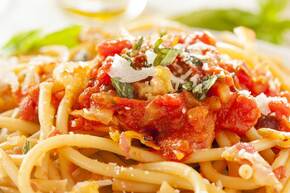 Pasta can feel like the ultimate winter comfort food – but it doesn’t have to be purely about indulgence. That’s never been more true now that there are so many pasta varieties that closely mimic the flavor and texture of traditional pasta while packing in extra nutrition. In addition to whole wheat pasta, consider protein-fortified options made from lentils and chickpeas, or fiber-rich soba noodles, to boost the health of your pasta dishes and provide some extra satisfaction to vegetarian guests. 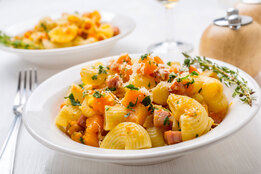 At a time when ingredients’ availability can be unpredictable, changing up the experience of your menu can be as simple as adjusting the grain at the foundation of a dish. For maximum impact of your pasta dishes, pair the sauce or dressing of each item with a pasta shape that will best amplify its flavors. Consider orzo to add subtle bulk to soups or salads, or use it as a risotto stand-in. Pair fettucine or other ribbon-shaped pastas with richer, meaty sauces, and thinner strands like vermicelli with oil- or cream-based sauces. Have a special sauce you’d like to show off? A pasta like lumache will hold the sauce in its ridges and capture even more of it in its curved, hollow center, ensuring you’re serving up a plate of perfect bites. 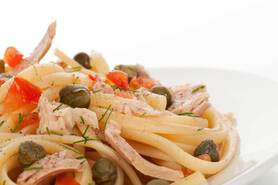 Remember when eating pasta felt like a guilty pleasure? It doesn’t have to anymore, thanks to the plethora of options available that can suit not only guests sensitive to gluten, but also those simply looking for their pasta to pack a more nutritious punch than the conventional variety. It’s an extra benefit when those alternative options don’t feel like a big sacrifice in the taste department. Consider offering options made from beans, chickpeas or lentils, fortified with protein and fiber, or made from sprouted grain. 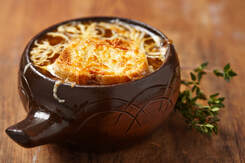 After a summer of unseasonably hot temperatures, the thought of cooler weather and cozy foods may be especially appealing to your guests. Think hearty soups and stews, pasta bakes, potato dishes and creative takes on macaroni and cheese. As you plan menus for the months ahead, consider how you can stretch your ingredients on hand, whether that includes produce that can support a pasta dish as well as a sandwich, or cuts of meat that you wouldn’t normally feature at the center of the plate but which can elevate a soup or savory pie. 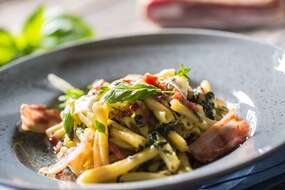 We could all use a little comfort these days – and as comfort foods go, pasta ranks pretty high. But at a time when many consumers are craving foods that soothe but also those that promote better health, restaurant operators need to offer options that that tick both boxes. Pasta made from alternatives to wheat flour – whether chickpeas, quinoa, red lentils or another source – can help. While these pastas are not necessarily low-carb, their elevated protein and fiber content make them reliable options to offer guests who want comfort without the guilt. 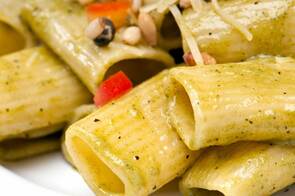 About 30 percent of Americans purposefully avoid gluten. Do you have some reliable go-to grains that help you adapt a dish as needed without sacrificing taste? Across your menu, consider where you might offer brown rice, quinoa, wild rice or gluten-free pastas in place of traditional white rice and pasta. Having a range of these staples on hand can help you stretch your menu – both for guests with gluten allergies and for others looking to customize their order with a nutrient-dense base. 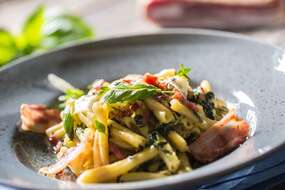 At a time when there’s so much pressure to simplify menus and do more with fewer ingredients, planning a menu can feel restricting for chefs. One thing that may help lend new interest to a recipe is bringing in a variety of ingredient shapes and textures. A different pasta shape can make a dish feel more upscale, while swapping in quinoa or freekeh for the noodles in a dish can make it an appealing option on your salad menu.  You’re likely serving more flexitarians these days – or people who simply want to increase their intake of vegetables in interesting, satisfying ways. Plant-forward pasta dishes are a great alternative for these guests because they can pack a dish full of nutrients without feeling restrictive. They’re also easy to adapt and customize with whatever vegetables happen to be available and in season (or with chicken, seafood or sausage for those who want a little meat). 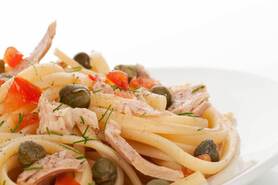 Is there a better foundational ingredient than pasta? At a time when operators need to make the most of their inventory, pasta is an especially valuable tool. It can add dimension to your salad menu, be upscaled with seafood, or add bulk to ingredients in a global dish. Yet it also shines alongside simple, fresh ingredients. Depending on the shapes used, it can make a dish feel more comforting, surprising or upmarket. 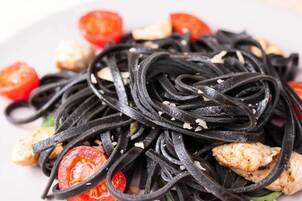 What’s more versatile than pasta? Treat it as a critical resource in your toolbox at a time when you need to make every item in your inventory count. It can be a tasty side dish when combined with fresh vegetables and a vinaigrette, offered as a craveable appetizer when baked with cheese or elevated to an entrée when paired with seafood. Serve it hot or cold, make it health-conscious or indulgent, and swap in different shapes to instantly kick up the interest of a recipe. |
Subscribe to our newsletterArchives
July 2024
Categories
All
|




 RSS Feed
RSS Feed